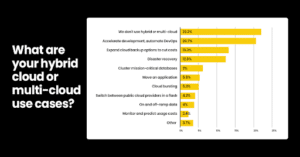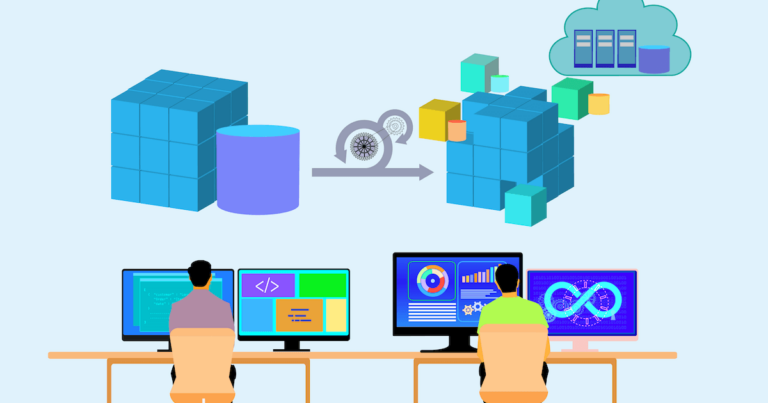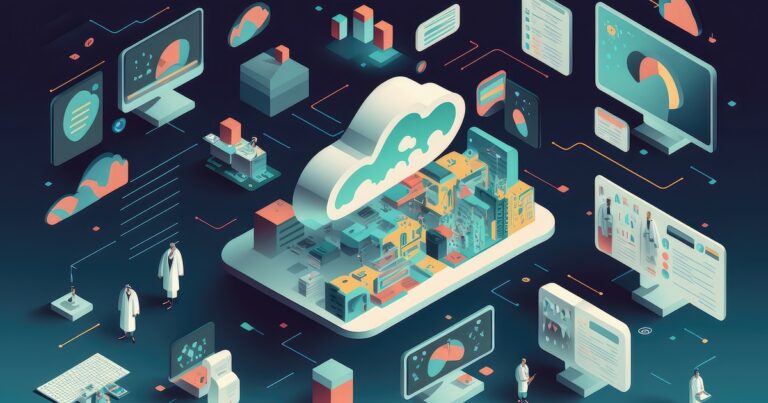In the early days of the evolution of technologies, enterprises adopted digital transformation as a survival mechanism. Sooner or later, companies realized digital transformation is a never-ending process. Instead of considering it a survival strategy, digital transformation has been viewed as a continuous improvement serving varied business objectives.
Therefore, enterprises have been adopting new technologies in the league of instilling increased efficiency and gaining a competitive advantage over competitors. While the hyperscalers have built modern applications for many years and have proven the concepts behind a new generation of infrastructure and applications, enterprises still have to face a different situation as most solutions aren’t built greenfield and are juggling with older generations of applications.
It is because most enterprise applications are lifted and shifted into new platforms only. Though it brought them an instant solution to the need, these don’t scale to support ever-evolving business needs. Therefore, enterprises have a dire need to modernize their applications. Modernizing applications with new-age technologies and practices propose multiple benefits to a company, but it is crucial to identify the exact use cases to design solutions and to take full advantage of modern technologies.
An enterprise can turn to application modernization services for a number of reasons. Here is a list of common yet crucial use-cases companies need to achieve to stay agile, meet their customer expectations, and maintain their competitive advantage.
1. Improved Security
Software applications come with a ‘use-by’ date, which applies to the most important enterprise applications. When digital transformation became central to businesses, applications were adopted across departments but left unchecked. Over time, legacy code inside these applications becomes a hindrance, limiting teams from innovating. Monolith legacy applications rely on older and more limited frameworks, software libraries, and operating systems. It creates knock-on problems when deploying these applications with newer software architectures and forces the DevOps team to expend resources trying to integrate and understand legacy code. Legacy code also hasn’t been written following standard procedures, likely suffering the sort of security issue difficult to mitigate.
Issues like these make the system vulnerable to security and cyber threats. Many viruses are designed to exploit this type of vulnerability. Ransomeware, Phishing, and DDoS attacks have caused companies millions in breach of security against infrastructure, applications, and business layers. Even attackers are actively focusing their attacks against the public cloud infrastructure. In these scenarios, only state-of-the-art security protects critical business infrastructure.
Application modernization allows companies to transition from into-out and vice-versa with updated tools, technologies, frameworks, and platforms, and even abandoning applications altogether not serving the purpose anymore.
Since everything from initial software development to customer experience depends on data integrity and efficiency, modernizing older applications helps improve data quality in workflows. Organizations can reduce bottlenecks arising from older systems, which almost always compromise new projects.
2. Increase Developer Productivity
Legacy systems hinder creativity, limiting access to data and insight for innovation, as stated by IBM & Forester in a paper. With aging systems, developers face interruptions and rework, which create worse experiences for them. For example, on Monday – a developer starts the day working on Feature A, commits it into Git, and finishes his day. On Tuesday, he spent the day writing Feature B, which has nothing to do with Feature A. When he is done, he commits the code into Git. He attended some meetings and started working on Feature C. On Wednesday, he finished working on Feature C and commit it to Git. Then he starts working on Feature D only to be interrupted by feedback stating there is some configuration error on Feature A in the middle of the day. Now he has to stop working on Feature D and jump back to focusing on the thought he had on Monday about feature A to fix the error.
These scenarios are very common and frustrating for developers and teams with legacy applications or traditional application development practices. It is holding them back from innovating and the cause of reduced development productivity and performance improvement as they spend most of their time fixing code written days before.
Unlike the traditional approach, modern application development practices focus more on enhancing the portability of applications across all environments. Plus, cutting-edge tools like IaaS and PaaS solutions help automate the deployment of workloads to the most suitable environments. Adapting to new development practices (DevOps and automation) provides developers feedback in real-time or at least when he is still thinking about the code that he has just contributed. Their days or week would look a lot different with automation. They write the code for a cool new customer feature, commit it into Git and forget about it. The next day, they work on another amazing new feature and commit it to Git without thinking about whether it will compile well with yesterday’s feature for the application. Hence, modern practices boost the developer’s productivity and the whole team’s performance and increase delivery time and confidence.
3. Accelerate Software Deployment Plus Development
“By 2023, more than 70% of global organizations will be running more than two containerized applications in production.” – Gartner
With agile development, companies achieved continuous development and continuous integration. It helped developers achieve better productivity and businesses better efficiency, but application deployment remains a manual process. Companies were still far from delivering greater customer experiences and innovating faster when and how their customers require.
Along with continuous integration in agile software development, a strong need is felt for continuous deployment to accelerate software delivery along with development. Modernizing applications and breaking monolithic applications into microservices, event-driven, and reactive applications while adopting advanced deployment mechanisms such as containers and serverless minimize these applications’ size and instill portability. It not only accelerates the development lifecycle but also automates the deployment lifecycle.
4. IoT/Edge Computing
Microservices, ephemeral functions, serverless, and edge computing are helping businesses to effectively leverage IoT advantages. Internet of Things (IoT) refers to smart devices connected over a network – sending and receiving data to and from other devices. These devices generate a good volume of data to be processed and analyzed. Edge computing facilitates computing on the location where data is collected, enabling IoT data to be gathered and processed at the edge. It mitigates the need to send the data back to a data center or cloud.
While this side of the architecture is key for creating business value – the question is, what is the best application architecture that uses IoT data and analytics?
That is where it is important to talk about the modernization of applications. You may certainly consider an application as ‘legacy’ built on mainframe technology and COBOL. But the fact is, even the java applications and related app servers are legacies for IoT and Edge computing. Java architectures use the concept of an archive file, package completed apps, and represent the entire application. With this kind of application architecture, it is not possible to modify one element of the application. It complicates the scaling of the application, decreases latency, and wastes resources.
Therefore, modern application development approaches are essential as it allows capabilities to be abstracted, enabling independent modification and enhancement of an element of the application. Microservices, serverless, and ephemeral architecture and computing models provide the flexibility and agility needed to support the workloads.
Organizations that can’t afford to re-write all of their legacy apps can identify slices of functionality that are widely used and should be modernized to adopt and support IoT initiates – and you could benefit by turning this functionality into capabilities that new workloads can consume with a modern API.
5. Reliability/Availability/Scalability
Not every organization prioritizes application modernization for cost optimization. Some have far bigger goals, such as reliability and stability of their system, reliability of digital services, and scalability for better resource utilization. Organizations look for migration and modernization solutions to meet these business objectives. Companies pick the most appropriate application modernization approach based on a unique business case. Lifting and shifting, refactoring, rearchitecting, rebuilding, and replacing are some of the methods used by organizations.
Companies are widely moving and leveraging cloud-based resources to achieve varied business objectives. Amazon Web Services, Azure, and Google Cloud platforms are making this possible for all scale organizations with a promise of 99.99% SLA. Organizations in all industries, including the most traditional ones such as manufacturing, financing, banking, and others, are also turning to cloud adoption for better availability, reliability, disaster recovery, and backup solutions. Statista found that market revenue for cloud backup technology worldwide will eventually reach 6.82 billion U.S. dollars by 2025, growing with a compound annual growth rate of 23.4 percent from 2017.
(Learn the process of designing cloud backup strategy and how it works.)
(Polish your basics again on disaster recovery in cloud for better cloud optimization and implementation.)
6. Support Cloud-Native, Microservices Architecture
When the cloud evolved, companies thought of the cloud as an alternative data center. They lifted their workloads and shifted them to the public cloud. Since companies haven’t adopted the cloud as a core part of their business strategy, they achieved marginal gains and remain restricted from unlocking the true cloud benefits. Lift and shift projects don’t develop native-cloud skills. It is difficult to extract additional value from a legacy workload and achieve cloud-native benefits like automated performance management and stability.
Their application architecture remains the same as for on-premises deployments. For example, they are not designed to scale horizontally, which means they cannot increase or decrease capacity to suit changing loads. Instead, you may have to provision larger cloud servers to support the load, as you would do it on-premises. This gives you a monthly bill for the resources, even if they are not fully utilized.
Therefore, companies are modernizing their applications and transforming them as cloud-native to be resilient, reliable, scalable, secure, and optimized for cost from the beginning.
7. Data Modernization
Legacy data is historical data buried in old databases but holds vital information for the company. Being stored for ages, these data become disordered, siloed, and segmented in different formats. It makes managing and processing legacy data overly cumbersome and useless over time. It drives moving legacy databases to modern environments.
Many companies have shifted from a data architecture of rational enterprise data warehouses to data lakes based on open-source tools such as Hadoop. But they may not have eliminated warehouses completely, as these data storage options are still useful for many applications involving structured data. But these companies are adapting to data modernization to support new business applications. The advantage of modern or cloud-based data platforms is that organizations can access any amount of resources needed by big data applications. Automated resource provisioning (automated scaling up and scaling down) and flexibility of the pay-as-you-go model are yet another reason companies are adopting modern infrastructure for data.
8. Increase App Development Speed/Time To Market
Because business leaders feel increasing pressure to drive innovation, digital trends, remote work, and escalating customer expectations are among the reasons. Application modernization helps achieve the goals when businesses modernize applications; it drives new processes and the necessary infrastructure to accelerate innovation and go to market faster by updating business processes, including modernizing CI/CD, reducing maintenance costs, and making data more accessible. Key technologies supporting the vision are:
-
Microservices
By modernizing an application to a greater microservices architecture, components are smaller, loosely coupled, and can be deployed and scaled independently of each other.
-
Containers
Containerization enables an application to be packaged in consistent, lightweight ways to run consistently across desktop, cloud, or on-premises environments. These flexibility benefits organizations that are charting their path forward in the cloud.
-
Orchestration and Automation
Companies deploy a wide range of infrastructure across multiple clouds and operating environments for strategic modern application delivery. To enable an application to remain portable and run efficiently in multiple places, container management platforms such as Kubernetes or Docker Swarm that automate many operational tasks associated with containers, including deployment, scaling, and networking.
-
Cloud Computing
Cloud technologies significantly support and fuel application modernization initiatives. Today’s primary destination for application migration efforts is unquestionably the cloud. This includes public cloud platforms, private clouds, and hybrid clouds. Besides IaaS and SaaS solutions, PaaS has emerged as the top choice among developers for modern application development, helping them tap into the pool of resources, tools, and libraries needed to innovate and deliver software development faster.
9. Reduce Infrastructure Costs/Improve Efficiency
Adopting modern application development practices makes infrastructure management effortless. For example, serverless platforms such as AWS Lambda and Azure function don’t need to be managed or worry about operating like configuring networking, allocating storage, and provisioning cloud instances. Therefore, companies leverage productivity boosts for their development team. The increased efficiency allows development teams to maintain a competitive advantage and more frequently deliver new features to customers.
Moreover, cloud-based or cloud-native development solutions further help reduce infrastructure costs. For example, serverless architecture charges organizations for triggered events aside from the pay-as-you-go cloud pricing advantage. That means you need to pay only when you consume cloud resources. Henceforth, serverless architecture has found numerous use-cases across industries, helping enterprises reduce infrastructure costs. It saves organizations from having to pay for instances that are either idle or have low utilization.
10. Move Off Old/Unsupported Operating Systems
Servers or operating systems also have a life. For example, Microsoft has reminded customers that Windows Server 2012/2012 R2 will reach its extended end-of-support (EOS) date next year, on October 10, 2023. The company’s relational database management system has retired on July 12, 2022, ten years after its release in May 2012. End of support means the end of regular security updates to the operating systems and applications affected, leaving systems vulnerable to cyberattacks. Perhaps you’re trying to save a few bucks by running legacy applications, but there really are some risks. Let’s check a few:
-
Software incompatibility
Modern applications are developed using the most recent OSes. It means your IT infrastructure doesn’t allow you to upgrade to the latest and greatest systems. It holds you onto legacy applications.
-
Compliance Issues
Many states and countries have developed and made a standard to use and store data. Companies are bound to modify their systems if dealing with sensitive data such as healthcare and e-commerce. Running these industries with a decade-old OS or an unsecured application can cause companies not just security lapses but also can turn into big fines, company shutdowns, or possible jail time.
-
High Operating Costs
Companies spend a high cost on maintaining and bug-fixing applications running on post-EOD software, which is also a steep process. Additionally, the cost of paying Microsoft to patch an EOL operating system involves a commitment of a huge sum of money. You can imagine now what cost could be associated with maintaining a mission-critical app if it fails.
-
Poor Performance and Reliability
If you are running your business on legacy apps or old versions of windows, chances are you may have aging servers and workstations around the office too. These aging devices are prone to break – you may have also experienced it. These add to your risk and lead to increased downtime, which could be more costly than an overdue upgrade.
Security, compatibility, and compliance are all big problems with outdated software or OSes. It is also one of the significant reasons continuous modernization of business applications is crucial: it keeps your IT updated and provides you the speed to grow as you envision.
11. Pursue A Multi-Cloud/Hybrid Cloud Strategy
According to a report by Statista in Feb 2022 – the hybrid cloud market was worth 56 billion U.S. dollars in 2020, which is expected to reach 145 billion U.S. dollars in 2026. Moreover, when asked with the respondents’ organizations in 2021 about their primary uses of hybrid or multi-cloud, roughly 22 percent of respondents indicated that their organizations do not use the hybrid or multi-cloud. This clearly shows these organizations are still running on legacy systems.
However, 20.7 % of respondents showed interest in hybrid and multi-cloud to accelerate development & automate DevOps, while 13.3% of respondents were willing to expand cloud backup options to cut costs, and 12.6% were interested in disaster recovery options followed by developing capabilities to monitor and predict usage costs and others. (see the chart below)

Source: Statista
Hence, hybrid and multi-cloud adoption is yet another driver behind application modernization, promising organizations to run processes smoothly and scale up traditional or cloud-native systems.
Read yet another insight shared on how to develop a cloud-native application and crucial components of cloud-native applications.




